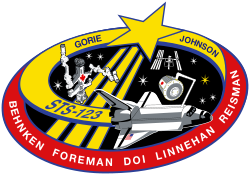Michael James Foreman
| Michael James Foreman | |
|---|---|
 Michael James Foreman | |
| Astronaut NASA | |
| Státní příslušnost | |
| Datum narození | 29. března 1957 (65 let) |
| Místo narození | Columbus, Ohio |
| Předchozí zaměstnání | letec |
| Hodnost | kapitán |
| Čas ve vesmíru | 26 dní, 13 hodin a 27 minut |
| Kosmonaut od | 1998 |
| Mise | STS-123, STS-129 |
| Znaky misí | |
| Některá data mohou pocházet z datové položky. | |
Michael James Foreman (*29. března 1957 v Columbusu, stát Ohio) je americký letec a kosmonaut. Ve vesmíru byl dvakrát.
Život
Studium a zaměstnání
Absolvoval střední školu Wadsworth High School v Wadsworth (1975), poté nastoupil na námořní akademii US Naval Academy. Dostudoval zde v roce 1979 a zůstal v armádě jako pilot. Později absolvoval postgraduální studium na Naval Postgraduate School v Monterey. Toto zakončil v roce 1986, i nadále zůstal pilotem.
V letech 1998 až 2000 absolvoval výcvik budoucích kosmonautů v Houstonu, poté byl zařazen do tamní jednotky astronautů NASA.
Oženil se, jeho manželkou se stala Lorrie Dancerová.
Lety do vesmíru
Na oběžnou dráhu se v raketoplánu dostal dvakrát ve funkci letový specialista, pracoval na orbitální stanici ISS, strávil ve vesmíru 26 dní, 13 hodin a 27 minut. Absolvoval také pět výstupů do volného vesmíru (EVA), strávil tam celkem 32 hodin a 19 minut. Byl 470 člověkem ve vesmíru.
- STS-123 Endeavour (11. března 2008 – 27. března 2008)
- STS-129 Atlantis (16. listopadu 2009 – 27. listopadu 2009)
Odkazy
Externí odkazy
 Obrázky, zvuky či videa k tématu Michael James Foreman na Wikimedia Commons
Obrázky, zvuky či videa k tématu Michael James Foreman na Wikimedia Commons - Na webu Space
- Na webu MEK-Kosmo
Média použitá na této stránce
Astronaut Michael J. Foreman, mission specialist
For STS-129 the sun shines brightly on the International Space Station (ISS) above and the United States below representing the bright future of U.S. human spaceflight. The contiguous U.S., Rocky Mountains, and Great Desert Southwest are clearly visible on the earth below encompassing all the NASA centers and the homes of the many dedicated people that work to make our Space Program possible. The integrated shapes of the patch signifying the two Express Logistics Carriers that will be delivered by STS-129 providing valuable equipment ensuring the longevity of the ISS. The Space Shuttle is vividly silhouetted by the sun highlighting how brightly the Orbiters have performed as a workhorse for the U.S. Space Program over the past 3 decades. The Space Shuttle ascends on the Astronaut symbol portrayed by the Red, White and Blue swoosh bounded by the gold halo. This symbol is worn with pride by this U.S. crew representing their country on STS-129. The names of the crew members are denoted on the outer band of the patch. As STS-129 launches, the Space Shuttle is in its twilight years. This fact is juxtaposed by the 13 stars on the patch which are symbolic of our children who are the future. The Moon and Mars feature predominantly to represent just how close humankind is to reaching further exploration of those heavenly bodies and how the current Space Shuttle and ISS missions are laying the essential ground work for those future endeavors.
STS-123 continues assembly of the International Space Station (ISS). The primary mission objectives include rotating an expedition crew member and installing both the first component of the Japanese Experimental Module (the Experimental Logistics Module - Pressurized Section (ELM-PS)) and the Canadian Special Purpose Dexterous Manipulator (SPDM). In addition, STS-123 will deliver various spare ISS components and leave behind the sensor boom used for inspecting the shuttle's thermal protection system. A follow-on mission to ISS will utilize and then return home with this sensor boom. A total of five spacewalks are planned to accomplish these tasks. The mission will also require the use of both the shuttle and ISS robotic arms. STS-123 will utilize the Station-Shuttle Power Transfer System to extend the docked portion of the mission to eleven days, with a total planned duration of 15 days. The crew patch depicts the space shuttle in orbit with the crew names trailing behind. STS-123's major additions to ISS (the ELM-PS installation with the shuttle robotic arm and the fully constructed SPDM) are both illustrated. The ISS is shown in the configuration that the STS-123 crew will encounter when they arrive.



